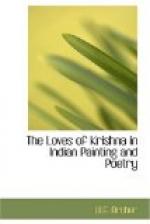Purkhu was clearly one of the greatest artists ever to practise in the Punjab Hills, but it is a certain Kushala who is supposed to have been Sansar Chand’s special favourite. We do not know which pictures are by his hand but there exist two series of illustrations of such distinctive quality that Kushala may well have been responsible.[117] One is a series of paintings illustrating part of Bihari’s Sat Sai—the seven-hundred poems in which he extolled Krishna’s love-making.[118] The other is yet another version of the Gita Govinda where Krishna is shown consorting with the cowgirls in blissful abandon.[119] In both these series, the inherent loveliness of Radha and the cowgirls is expressed by supple flowing line, a flair for natural posture and the inclusion of poetic images. The scarlet of a cowgirl’s skirt is echoed by the redness of a gathering storm, the insertion of Krishna into the background suggesting the passionate nature of their imminent embraces.[120] In a similar way, the forest itself is ‘threaded with phases of passion’ and slender trees in flower parallel the slim romantic girls who long for Krishna’s love.
One other Kangra master remains to be mentioned. Besides the pictures already noted, there exists a further series illustrating the tenth book of the Bhagavata Purana. The artist’s identity is once again uncertain, but just as the Garhwal master was fascinated by the swirl of curling water, the Kangra artist in question delighted in the blonde pallor of the Indian moon.[121] Each incident in the text is rendered as if in moonlight—a full moon riding in the sky, its pale reflection shining in water, the countryside itself bathed throughout in frosty whiteness. As a result the figures of Radha and the cowgirls seem imbued with pallid glamour, their love for Krishna with an almost unearthly radiance.
Kangra painting continued throughout the nineteenth century but it was only during Sansar Chand’s own reign (1775-1823) that the style achieved great lyrical glory. Similarly it was only towards the end of the eighteenth century that other states in the Punjab Hills developed their own interpretations of the great impassioned theme. At Nurpur, Chamba, Kulu and Bilaspur[122] pictures of Krishna had temporary vogues and at all these places artists created new modes of expression. None of the local styles, however, possessed the same prestige as that of Kangra and all were subsequently obliterated by the general Kangra manner. By the mid-nineteenth century, the Rajput order in the Punjab Hills foundered before the British and while lesser nobles and merchants continued to purchase pictures of Krishna the cult as a whole declined in princely favour. Only in Eastern India and then mainly in the villages did delight in Krishna continue to evoke new painting. From the twelfth century onwards Bengal had constantly celebrated the loves of Krishna—the poets Jayadeva, Chandi Das and Vidyapati being all natives




